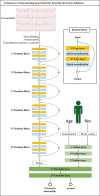Artificial intelligence for detecting electrolyte imbalance using electrocardiography
- PMID: 33719135
- PMCID: PMC8164149
- DOI: 10.1111/anec.12839
Artificial intelligence for detecting electrolyte imbalance using electrocardiography
Abstract
Introduction: The detection and monitoring of electrolyte imbalance is essential for appropriate management of many metabolic diseases; however, there is no tool that detects such imbalances reliably and noninvasively. In this study, we developed a deep learning model (DLM) using electrocardiography (ECG) for detecting electrolyte imbalance and validated its performance in a multicenter study.
Methods and results: This retrospective cohort study included two hospitals: 92,140 patients who underwent a laboratory electrolyte examination and an ECG within 30 min were included in this study. A DLM was developed using 83,449 ECGs of 48,356 patients; the internal validation included 12,091 ECGs of 12,091 patients. We conducted an external validation with 31,693 ECGs of 31,693 patients from another hospital, and the result was electrolyte imbalance detection. During internal, the area under the receiving operating characteristic curve (AUC) of a DLM using a 12-lead ECG for detecting hyperkalemia, hypokalemia, hypernatremia, hyponatremia, hypercalcemia, and hypocalcemia were 0.945, 0.866, 0.944, 0.885, 0.905, and 0.901, respectively. The values during external validation of the AUC of hyperkalemia, hypokalemia, hypernatremia, hyponatremia, hypercalcemia, and hypocalcemia were 0.873, 0.857, 0.839, 0.856, 0.831, and 0.813 respectively. The DLM helped to visualize the important ECG region for detecting each electrolyte imbalance, and it showed how the P wave, QRS complex, or T wave differs in importance in detecting each electrolyte imbalance.
Conclusion: The proposed DLM demonstrated high performance in detecting electrolyte imbalance. These results suggest that a DLM can be used for detecting and monitoring electrolyte imbalance using ECG on a daily basis.
Keywords: artificial intelligence; deep learning; electrocardiography; electrolytes.
© 2020 The Authors. Annals of Noninvasive Electrocardiology published by Wiley Periodicals LLC.
Conflict of interest statement
KHK, KHJ, SYL, and BHO declare that they have no competing interests. JK and JP are co‐founder, and YYJ, MSJ, YJL, YHC, and JHS are researchers of Medical AI Co., a medical artificial intelligence company. JK and JHB are researchers of Bodyfriend Co. There are no products in development or marketed products to declare. This does not alter our adherence to Journal.
Figures




References
-
- Arampatzis, S. , Funk, G.‐C. , Leichtle, A. B. , Fiedler, G.‐M. , Schwarz, C. , Zimmermann, H. , Exadaktylos, A. K. , & Lindner, G. (2013). Impact of diuretic therapy‐associated electrolyte disorders present on admission to the emergency department: A cross‐sectional analysis. BMC Medicine, 11(1), 83. 10.1186/1741-7015-11-83 - DOI - PMC - PubMed
-
- Attia, Z. I. , Friedman, P. A. , Noseworthy, P. A. , Lopez‐Jimenez, F. , Ladewig, D. J. , Satam, G. , Pellikka, P. A. , Munger, T. M. , Asirvatham, S. J. , Scott, C. G. , Carter, R. E. , & Kapa, S. (2019). Age and sex estimation using artificial intelligence from standard 12‐lead ECGs. Circulation: Arrhythmia and Electrophysiology, 12(9), e00728410. 10.1161/CIRCEP.119.007284 - DOI - PMC - PubMed
-
- Attia, Z. I. , Kapa, S. , Lopez‐Jimenez, F. , McKie, P. M. , Ladewig, D. J. , Satam, G. , Pellikka, P. A. , Enriquez‐Sarano, M. , Noseworthy, P. A. , Munger, T. M. , Asirvatham, S. J. , Scott, C. G. , Carter, R. E. , & Friedman, P. A. (2019). Screening for cardiac contractile dysfunction using an artificial intelligence–enabled electrocardiogram. Nature Medicine, 25(1), 70–74. 10.1038/s41591-018-0240-2 - DOI - PubMed
-
- Attia, Z. I. , Noseworthy, P. A. , Lopez‐Jimenez, F. , Asirvatham, S. J. , Deshmukh, A. J. , Gersh, B. J. , Carter, R. E. , Yao, X. , Rabinstein, A. A. , Erickson, B. J. , Kapa, S. , & Friedman, P. A. (2019). An artificial intelligence‐enabled ECG algorithm for the identification of patients with atrial fibrillation during sinus rhythm: A retrospective analysis of outcome prediction. The Lancet, 394(10201), 861–867. 10.1016/S0140-6736(19)31721-0 - DOI - PubMed
-
- Balcı, A. K. , Koksal, O. , Kose, A. , Armagan, E. , Ozdemir, F. , Inal, T. , & Oner, N. (2013). General characteristics of patients with electrolyte imbalance admitted to emergency department. World Journal of Emergency Medicine, 4(2), 113–116. 10.5847/wjem.j.issn.1920-8642.2013.02.005 - DOI - PMC - PubMed
Publication types
MeSH terms
LinkOut - more resources
Full Text Sources
Other Literature Sources

